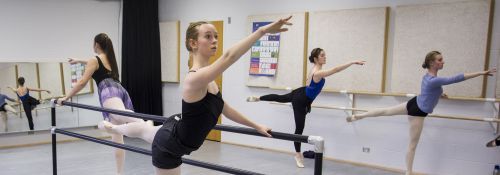
Athletes Who Make Art
Written by Madeleine Jepsen
When most people think of dance, they picture the austere grace of a tutu-clad ballerina leaping across the stage. Visiting assistant professor of dance Holly Hobbs, however, says Hillsdale’s dance minor offers much more than classical ballet, offering everything from Highland to modern dance for all experience levels.
Modern dance provides dancers with unique physical challenges, and the freer movement lends itself to a certain freedom of the mind.
“It also provides an opportunity for students to develop their expressive side and their creativity,” she says. “It’s not that it’s not disciplined; there’s just more freedom in the body. Dancers are athletes who make art. We train our bodies every day. We have a tremendous amount of discipline.”
The creative differences in the expression of modern dance extend beyond dancers’ performances to the manner in which instructors teach their students.
“Modern is definitely tied more to the individual, so each teacher will bring their own personal style, their own technique in a way,” Holly says. “So there are certainly major techniques that we study, but each teacher is going to bring something vastly different to the table—even more so than in classical ballet.”
Along with beginner, intermediate, and advanced ballet classes, the dance program offers classes in modern dance, jazz, social dance, Highland dance, choreography, Pilates, and dance history.
“Dance today has evolved and changed beyond those famous ballets to include a lot more abstraction and modern technique, like releasing the head and releasing the body from the vertical axis, which involves taking the body off center,” she says. “Those all factor into the development of ballet today. So it’s a changing and evolving art. I think often people think about those famous ballets, and they think that that’s the only possibility, and it’s really not.”
To an outside observer, modern dance may look undisciplined or disorganized compared to the rigid, methodical bar work of classical ballet, but Hobbs says this couldn’t be further from the truth.
“There is a misconception that modern is unstructured, and Twyla Tharp, a famous choreographer, has a famous saying: ‘Modern dance is not less, modern dance is more!’ It’s everything you have to do in ballet, and you have to take your torso off the center and move your head around. You have to be able to roll on the floor, and you have to have all of the technique and alignment and the training and discipline of the body, but you’re also developing your expressiveness. Modern is an expressive dance form. You’re dancing with your whole body. In classical ballet, we’re focusing primarily on the legs and the arms and aligning our body with the center.”
Holly says she tries to make each class productive but enjoyable, regardless of the style of dance she is teaching.
“Types of dance are vastly different,” she says. “I think my fundamental approach to teaching is the same, in that I try to craft my classes in a way that will develop dancers’ abilities and also be engaging and fun, and hopefully increase their performance ability.”
Part of this effort has been implementing the National Ballet Theatre curriculum, which combines a variety of teaching methodologies from around the world to maximize dancers’ movement.
“With this method you increase only one thing at a time,” she says. “You increase the duration or intensity of your training, but the idea is to do it in increments, where the exercises correct the habit or the technical element that you’re trying to perfect. So those sorts of things help you as a teacher. Especially here, where we have dancers of all types of level—dancers who have never danced at all and dancers who have been dancing their whole lives. It’s great to have one, unifying method of training to unite our program and center it around.”
Although dance classes have long been offered for Hillsdale students, the opportunity to take classes under the umbrella of a minor has been a more recent development. Holly says the new curriculum and flourishing participation have made Hillsdale’s dance program a vibrant department to be a part of.
Outside of classes, dance enthusiasts of all experience levels can audition to join Tower Dancers, who rehearse dances for an annual spring concert featuring faculty, student, and guest choreography.
“It’s an exciting place to be because we’re growing,” she says. “The program is relatively new—Hillsdale has always had dance of some sort, but the dance minor has been a new program in the last two or three years. That’s really helping us to train dancers and build our program further.”
Madeleine Jepsen, ‘18, studies biochemistry and journalism. Outside the classroom, Madeleine serves as a reporter and assistant editor for the Collegian. She is also involved in Catholic Society.